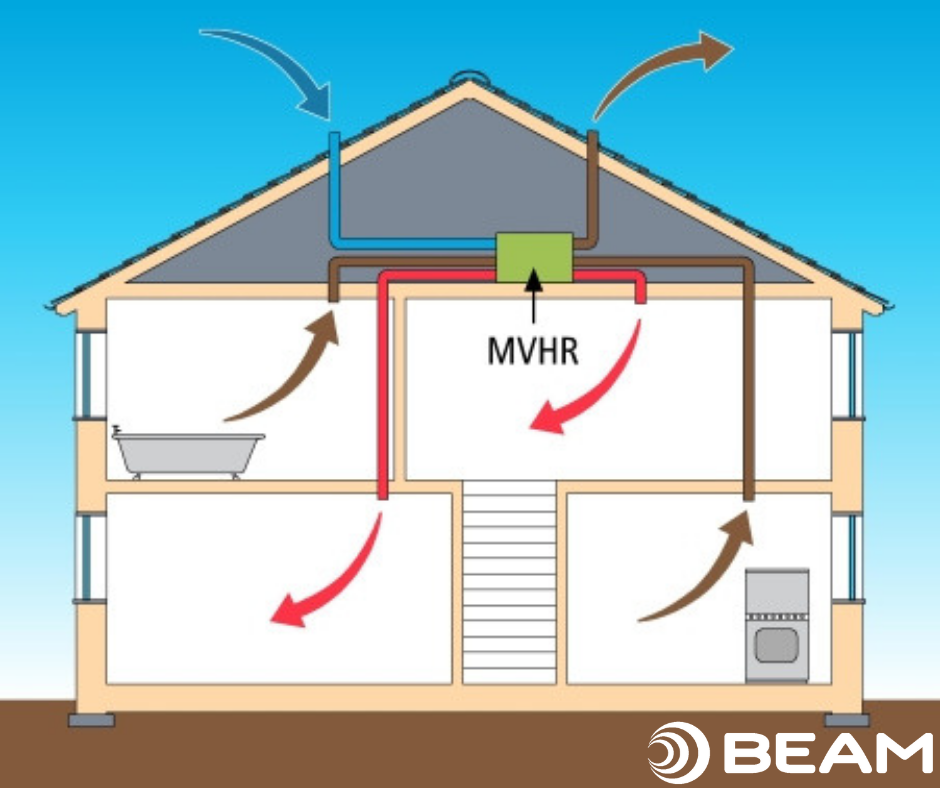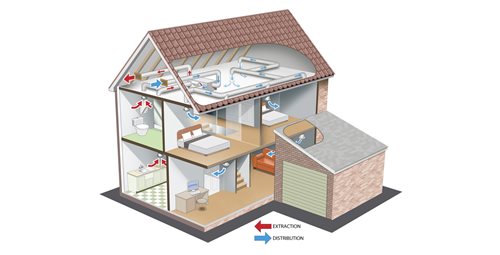What is MVHR and How Does it Work?
Date: 05 November 2021

Here are all of the questions our clients regularly ask about MVHR (Mechanical Ventilation with Heat Recovery) for new build and existing homes.
An important consideration when building your home is how you plan on ventilating your property.
This is especially important if you are investing in a high level of insulation, triple glazed windows etc. with the aim of building an airtight home to prevent heat loss and improve energy efficiency.
You may like to read our blog: Why ventilate your home?
What is MVHR?
MVHR is a whole home ventilation system that extracts stale air from the home and brings in fresh, filtered air. The key feature of the MVHR system is that it retains up to 95% of heat that's normally lost through open windows, trickle vents and extractor fans, allowing you to make valuable energy savings.
The system includes a unit which is usually installed in the roof space, and a network of ducting which is installed within the walls of your home, much like your electric cables and plumbing.
You may like to read more on: What is Heat Recovery Ventilation
At BEAM, we provide a free ducting layout design service for all clients. Plus, we only use smooth flow solid ducting and high-quality fittings to seal every joint, ensuring the most efficient set-up for your system.
You may like to read our blog: MVHR ducting – Why it really matters
What does MVHR stand for?
MVHR stands for Mechanical Ventilation with Heat Recovery. It is also referred to as Heat Recovery Ventilation.
How does Heat Recovery Ventilation work?
The concept of an MVHR system is simply to bring fresh air from the outdoors into the unit and at the same time extract warm moist air from wet rooms within the home. Both airflows will pass through a heat exchanger where heat is transferred from the extracted air to the fresh filtered air. The fresh filtered air is then distributed to living areas within the home.
Let’s look at how MVHR works step by step:
- Fresh air is drawn in from outside and filtered through the MVHR unit, removing pollutants and insects.
- At the same time, stale, moist air is extracted from wetrooms like bathrooms, WCs, kitchens and utility rooms.
- Both airflows pass through a heat exchanger where heat is transferred from the extracted air to the fresh filtered air, recovering most of the heat from the home that would otherwise have been lost.
- This warmed, fresh, filtered air is then distributed to living areas within the home via discrete supply valves in the ceiling.
This process of air movement results in the air within the house changing completely approximately every 2 hours (dependent on fan speeds). Ventilation, therefore, provides a method of improving air quality within the home, which can bring numerous health benefits. The added benefit of MVHR is that the 'recovered' heat can off-set some of your energy costs and help reduce your fuel bills.
You may like to read more on: What is Heat Recovery Ventilation and How Does It Work
Mechanical Ventilation with Heat Recovery vs Air Conditioning
MVHR is not to be confused with air conditioning – the process of warming or cooling air that is already present in the room. As MVHR facilitates air movement, and the exchange of heat that is already present within the home, it will NOT cool or heat the air to a temperature greater than that already existing inside the house. A system provided by BEAM does include a Summer Bypass facility – whereby the incoming air avoids being warmed in the heat exchanger. This, however, will still NOT cool the air within the home that has been generated by extremely high solar gain – it would be best to open a window to help in this situation.
Is Heat Recovery Ventilation the right system for my home?
Heat Recovery Ventilation (MVHR) is the ideal solution for ventilating properties with high levels of air tightness. This whole home ventilation system is the most popular choice of mechanical ventilation for new build and self build homes.
MVHR also meets building control regulations under System 4 of the Ventilation Requirements.
You may like to read our blog: ‘Meeting Building Control Requirements for New Build Homes’ for information on our other ventilation options including Mechanical Extract Ventilation and Positive Input Ventilation.
For existing homes, it may be possible to have MVHR retrofitted. This would depend on key factors such as the style of the property and if there are building works being completed.
What are the benefits of a Mechanical Ventilation with Heat Recovery system?
An MVHR system has many benefits, including: 
- Contributes to the energy efficiency of the home.
- Improves indoor air quality.
- Reduces symptoms for asthma and allergy sufferers.
- Eliminates condensation and mould.
- Removes musty odours.
- No need for trickle vents or extractor fans.
You may like to read more on: The Benefits of MVHR
Do I need any other ventilation alongside my MVHR system?
MVHR is a whole home ventilation system and doesn’t require any other form of mechanical ventilation alongside it.
Can BEAM install the MVHR system?
It is vital that an MVHR system is installed and commissioned correctly in accordance with the strict guidelines set by building regulations. BEAM have a team of experienced technical engineers available on hand throughout Ireland to professionally install your ventilation system.
Systems can also be purchased on a DIY basis. If this is the case, BEAM can provide the design layout, all the necessary materials required and a system commissioning service (to meet building control requirements).
Get in touch
For expert advice on all your mechanical ventilation options, get in touch via our online contact form or call our team on +44 (0) 28 7963 2424.